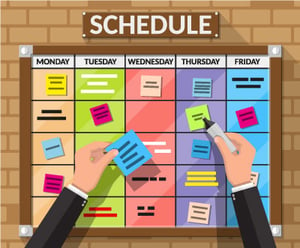How to Create a Study Schedule for the SAT or ACT

 Many high school students face challenges with SAT or ACT prep. How do you get started? How do you study? Since both are much different than the exams you take in high school, you absolutely have to approach them in a different way. One of the best ways to tackle SAT and ACT preparation is to create a study schedule for the months and weeks leading up to the test date. Here’s how you can do that.
Many high school students face challenges with SAT or ACT prep. How do you get started? How do you study? Since both are much different than the exams you take in high school, you absolutely have to approach them in a different way. One of the best ways to tackle SAT and ACT preparation is to create a study schedule for the months and weeks leading up to the test date. Here’s how you can do that.
Find Your Weaker Areas on the SAT or ACT
The best way to start approaching your SAT or ACT prep is to isolate your weaknesses. These are the steps you can take to find those points.
Take A Practice Test
The first step to SAT or ACT preparation can actually be taking a practice test! A practice test lets you learn the format of the standardized tests, see the structure of the questions and answers, discover how well you do when timed, and, of course, determine your areas of weakness.
Review Your Practice Test
However, it’s not enough to just take the practice tests. You want to actually take time to review them and mark what you answered incorrectly as well as correctly. Tally everything up and see which sections you did well on and which were lacking.
Understand Why You Got the Questions Wrong
And you need to go one step further: you have to understand why you got each question wrong. You may find you were in a hurry and read incorrectly, that you didn’t understand the question, that you made a simple mathematics mistake, that you didn’t know the correct formula, or that you simply had no clue how to answer a given question.
Identify Your Weaker Areas
Now that you’ve taken the SAT or ACT practice test, reviewed it, and understand why you got certain answers wrong, it’s time to identify your weaker areas. This could mean an entire subject, or a topic within a subject. You may have scored well on the math section, but answered many of the problem solving questions incorrectly. Or your didn’t do as well as you thought you would on the science section. You might even find that completing the sections under the time limits was frustrating for you and significantly impacted your score.
Wherever your issues lie, taking the practice test and carefully reviewing your answers will help you identify them.
What to Include In an ACT or SAT Study Schedule
Now that you know your weaker areas within the SAT or ACT, it’s time to study! However, as much as you want to improve on these weaker points, you definitely also want to take other things into consideration when creating your weekly study schedule. Your study schedule should comprise a few different things. They include:
- Taking practice SAT or ACT exams
- Reviewing your practice tests
- Seeing where you’ve improved or did worse than expected
- Studying your weaker points using various methods
- Write down your weaker areas. There are probably several, and that’s okay!
- Reviewing your stronger areas
- You don’t want to neglect these! There is always room for improvement and you also don’t want to lose your existing skills
- And don’t forget breaks!
How Many Hours Should You Study a Week for the SAT or ACT?
 Creating your SAT or ACT study schedule can get tricky, but there's one important thing to remember: don’t cram. You don’t want to burn yourself out. You shouldn’t be studying only the week leading up to your test date, and you shouldn’t be cramming in so much studying every single week that you can’t think of anything but the SAT or ACT. You have other responsibilities, from school work to college applications to chores. You’ll absolutely want to make sure you’re reserving time for everything you have going on in your life.
Creating your SAT or ACT study schedule can get tricky, but there's one important thing to remember: don’t cram. You don’t want to burn yourself out. You shouldn’t be studying only the week leading up to your test date, and you shouldn’t be cramming in so much studying every single week that you can’t think of anything but the SAT or ACT. You have other responsibilities, from school work to college applications to chores. You’ll absolutely want to make sure you’re reserving time for everything you have going on in your life.
Instead, devote a few hours each week to studying over several months. Four to six hours can be the perfect amount for SAT and ACT preparation, but if you find yourself with more free time, you can always devote a little extra each week.
Try two nights a week, two hours per night, to see how that works for you. But don’t push it. Studying more than a couple of hours in a row can actually be detrimental. It has been found that lengthy study sessions make it much harder for your brain to retain information, and after about three hours, very little will be saved in your memory banks!
Creating your SAT or ACT Prep Schedule
Now here’s the tricky part: Creating your SAT or ACT study schedule depends entirely on you and your needs. You’ll want to split your time up among the items listed above, but when you take your practice standardized tests depends entirely on you.
The best way to approach it is by taking practice exams when you feel you’re prepared. After you’ve spent a few days studying both your weaker and strong areas, there will be a time where you feel confident in what you’ve learned. And it’s time to put it to the test (literally). When you feel you’re ready, that’s when you should take another practice test.
After you’ve completed it, review the test, and again, see where your strengths and weaknesses lie. Did you improve? Did you do worse in another area? These tests will direct you to the next steps.
Four to six hours a week is optimal for many students preparing for the SAT or ACT, but what you do during that time depends entirely on your own needs and study habits. You can absolutely lay out a plan and think, “I will take a practice exam after two and a half weeks of study,” but you might also find that you feel confident in taking the test at the two week mark. It’s okay to tweak your schedule to your needs! But definitely find that time each week to devote to your study and don’t put it off or cram in the final weeks!
If you need help finding the right study schedule for you, or you’re not quite sure how to approach the actual studying, Method Test Prep can help. From online resources to online courses, we can help you get prepared for the SAT or ACT, on your schedule.


